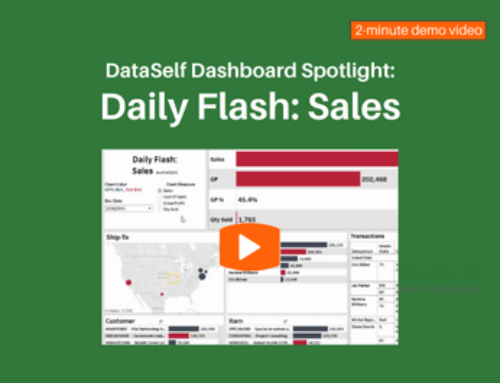A Tale of Two Reports: Staff-Oriented & Management-Oriented
Think about the people in your company who rely on your ERP system. You’ve got salesreps entering orders, warehouse staff ensuring there’s enough on hand, shipping clerks getting product out on time, and billing folks sending out invoices.
All of these people rely on your ERP system’s standard reports to find out what they need to do now, as well as confirm what they have done, and what’s coming in the future.
These ‘staff-oriented reports’ (such as ‘Sales Order Processing’, ‘Pending Shipments’, and ‘Stock Status’) work like microscopes in that they provide each staff member with insight into their daily business activities. These staff-oriented reports are typically included in your ERP solution.
However . . . these reports are of little help to managers.
Managers need visibility into KPIs such as which products are selling better, which salesreps are doing worse, and why. And managers need to look at what’s happening ‘now’ relative to what happened yesterday and what could or should happen tomorrow.
This requires a telescopic view of your business, and that’s where management-oriented reports come into play:
- Management-oriented reports help you understand which of your products sell best and what factors impact those sales. The result is more-informed decisions about sales methodologies, promotions, and targeted marketing.
- Management-oriented reports give you greater visibility into your financials (such as A/R Aging), letting you see payment trends and gauge the risk of A/R write-offs. The result is better decisions on whom to put on hold, start collections, or send dunning notices.
- Management-oriented reports let you project future inventory needs based on historic stock utilization, current inventory levels, and upcoming POs. The result is more timely decisions on future stock purchases, slow-moving items, and time-sensitive lots.
Due to their sophisticated nature, management-oriented reports are typically not well covered by ERP solutions. This is due to the following requirements of managerial reporting:
- Data Warehousing, Optimization & Blending. To help you make insightful decisions, management reports need access to a lot of data – often from multiple apps and/or ERP modules. This data has to be optimized for quick and easy analysis.
- Predictive & ‘What If’ Analysis. Management reports combine what ‘is happening’ with what ‘has happened’ and what ‘may happen’ for predictive insight on such things as cash-flow and potential inventory shortages.
- Powerful Search Technologies. Managers require a powerful and flexible plain-English search technology (like Google). This is typically found only in leading BI technologies.
- Graphic & Multi-Format Data Representation. To support the best decision-making, managerial reports can represented in multiple formats and ‘drilled’ into at any point.
- Extensive Library of Decision-Making Reports & Dashboards. Management reports – due to their variety and specificity by industry, role, etc., require far more report and dashboard templates – often into hundreds or thousands.
Although the preceding functionality is typically not found in standard ERP reports, it can be found under the categories of ‘Business Intelligence’ and ‘Analytical Reports’. One such management-oriented reporting solution is DataSelf.
DataSelf combines next-generation data optimization with a robust SQL Server data warehouse, and the industry-leading Tableau and Power BI business intelligence technologies. Additionally, DataSelf includes the largest library of pre-configured management-oriented reports and dashboards for all major ERP solutions.
And so – when considering who uses your ERP reports (and for what purpose), keep in mind that you have to provide two kinds of insight for your organization. Big and little, macro and micro, telescope and microscope. Your business needs both.



